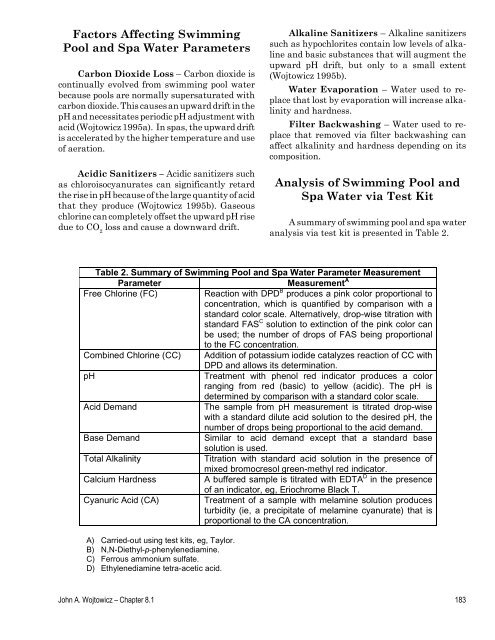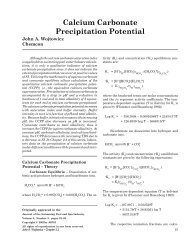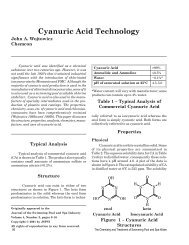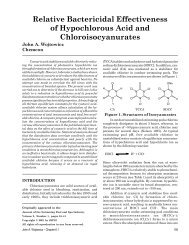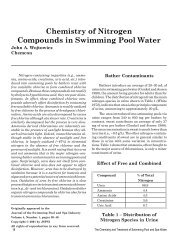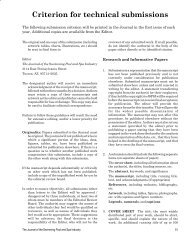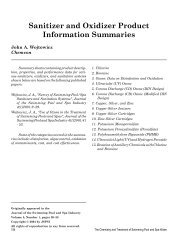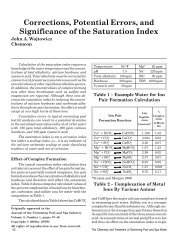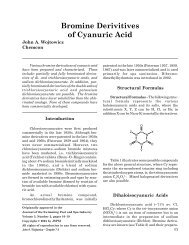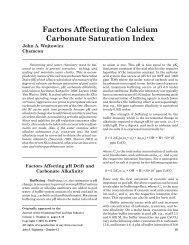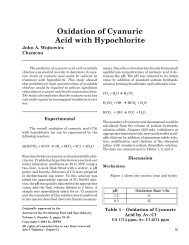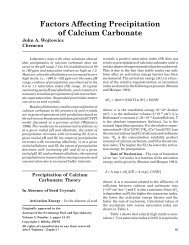Swimming Pool and Spa Water Chemical Adjustments - jspsi
Swimming Pool and Spa Water Chemical Adjustments - jspsi
Swimming Pool and Spa Water Chemical Adjustments - jspsi
You also want an ePaper? Increase the reach of your titles
YUMPU automatically turns print PDFs into web optimized ePapers that Google loves.
Factors Affecting <strong>Swimming</strong><br />
<strong>Pool</strong> <strong>and</strong> <strong>Spa</strong> <strong>Water</strong> Parameters<br />
Carbon Dioxide Loss – Carbon dioxide is<br />
continually evolved from swimming pool water<br />
because pools are normally supersaturated with<br />
carbon dioxide. This causes an upward drift in the<br />
pH <strong>and</strong> necessitates periodic pH adjustment with<br />
acid (Wojtowicz 1995a). In spas, the upward drift<br />
is accelerated by the higher temperature <strong>and</strong> use<br />
of aeration.<br />
Acidic Sanitizers – Acidic sanitizers such<br />
as chloroisocyanurates can significantly retard<br />
the rise in pH because of the large quantity of acid<br />
that they produce (Wojtowicz 1995b). Gaseous<br />
chlorine can completely offset the upward pH rise<br />
due to CO 2 loss <strong>and</strong> cause a downward drift.<br />
Alkaline Sanitizers – Alkaline sanitizers<br />
such as hypochlorites contain low levels of alkaline<br />
<strong>and</strong> basic substances that will augment the<br />
upward pH drift, but only to a small extent<br />
(Wojtowicz 1995b).<br />
<strong>Water</strong> Evaporation – <strong>Water</strong> used to replace<br />
that lost by evaporation will increase alkalinity<br />
<strong>and</strong> hardness.<br />
Filter Backwashing – <strong>Water</strong> used to replace<br />
that removed via filter backwashing can<br />
affect alkalinity <strong>and</strong> hardness depending on its<br />
composition.<br />
Analysis of <strong>Swimming</strong> <strong>Pool</strong> <strong>and</strong><br />
<strong>Spa</strong> <strong>Water</strong> via Test Kit<br />
A summary of swimming pool <strong>and</strong> spa water<br />
analysis via test kit is presented in Table 2.<br />
Table 2. Summary of <strong>Swimming</strong> <strong>Pool</strong> <strong>and</strong> <strong>Spa</strong> <strong>Water</strong> Parameter Measurement<br />
Parameter Measurement A<br />
Free Chlorine (FC) Reaction with DPD B produces a pink color proportional to<br />
concentration, which is quantified by comparison with a<br />
st<strong>and</strong>ard color scale. Alternatively, drop-wise titration with<br />
st<strong>and</strong>ard FAS C solution to extinction of the pink color can<br />
be used; the number of drops of FAS being proportional<br />
to the FC concentration.<br />
Combined Chlorine (CC) Addition of potassium iodide catalyzes reaction of CC with<br />
DPD <strong>and</strong> allows its determination.<br />
pH Treatment with phenol red indicator produces a color<br />
ranging from red (basic) to yellow (acidic). The pH is<br />
determined by comparison with a st<strong>and</strong>ard color scale.<br />
Acid Dem<strong>and</strong> The sample from pH measurement is titrated drop-wise<br />
with a st<strong>and</strong>ard dilute acid solution to the desired pH, the<br />
number of drops being proportional to the acid dem<strong>and</strong>.<br />
Base Dem<strong>and</strong> Similar to acid dem<strong>and</strong> except that a st<strong>and</strong>ard base<br />
solution is used.<br />
Total Alkalinity Titration with st<strong>and</strong>ard acid solution in the presence of<br />
mixed bromocresol green-methyl red indicator.<br />
Calcium Hardness A buffered sample is titrated with EDTA D in the presence<br />
of an indicator, eg, Eriochrome Black T.<br />
Cyanuric Acid (CA) Treatment of a sample with melamine solution produces<br />
turbidity (ie, a precipitate of melamine cyanurate) that is<br />
proportional to the CA concentration.<br />
A) Carried-out using test kits, eg, Taylor.<br />
B) N,N-Diethyl-p-phenylenediamine.<br />
C) Ferrous ammonium sulfate.<br />
D) Ethylenediamine tetra-acetic acid.<br />
John A. Wojtowicz – Chapter 8.1 183


